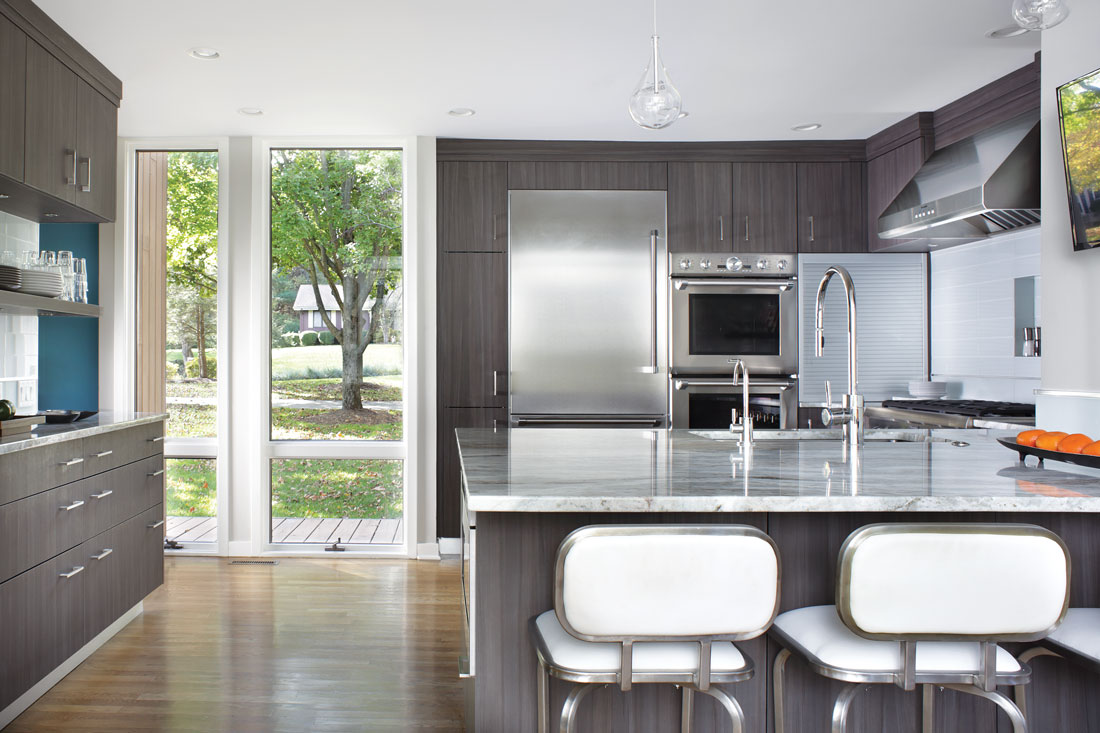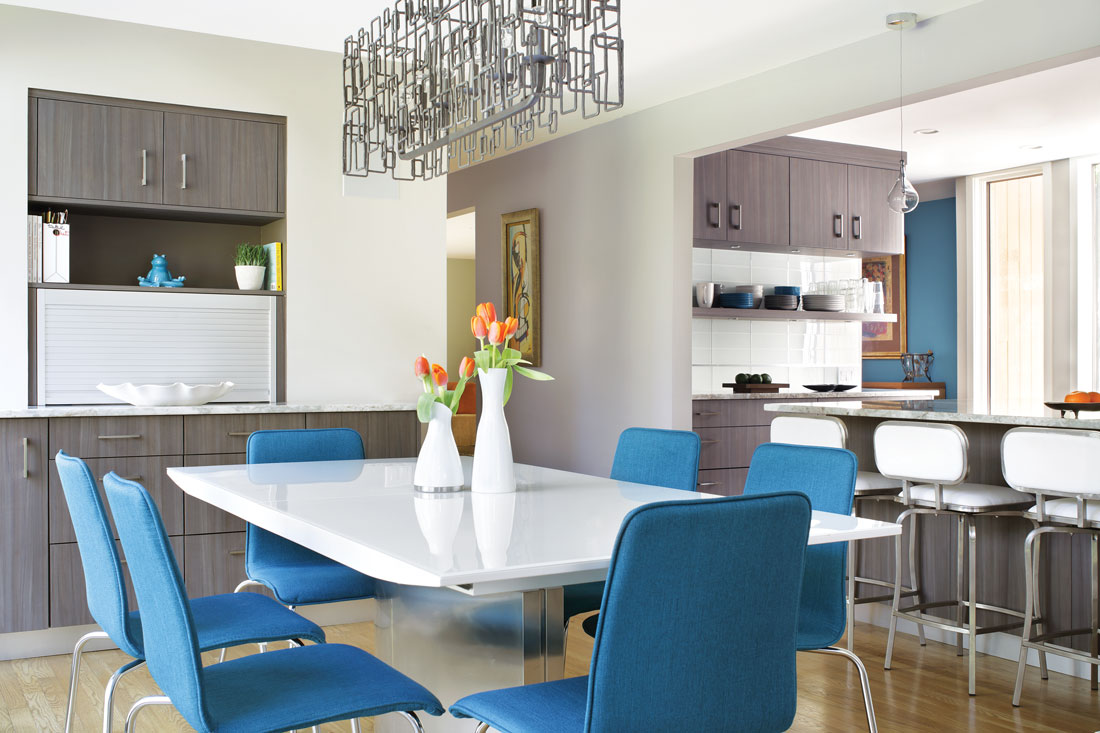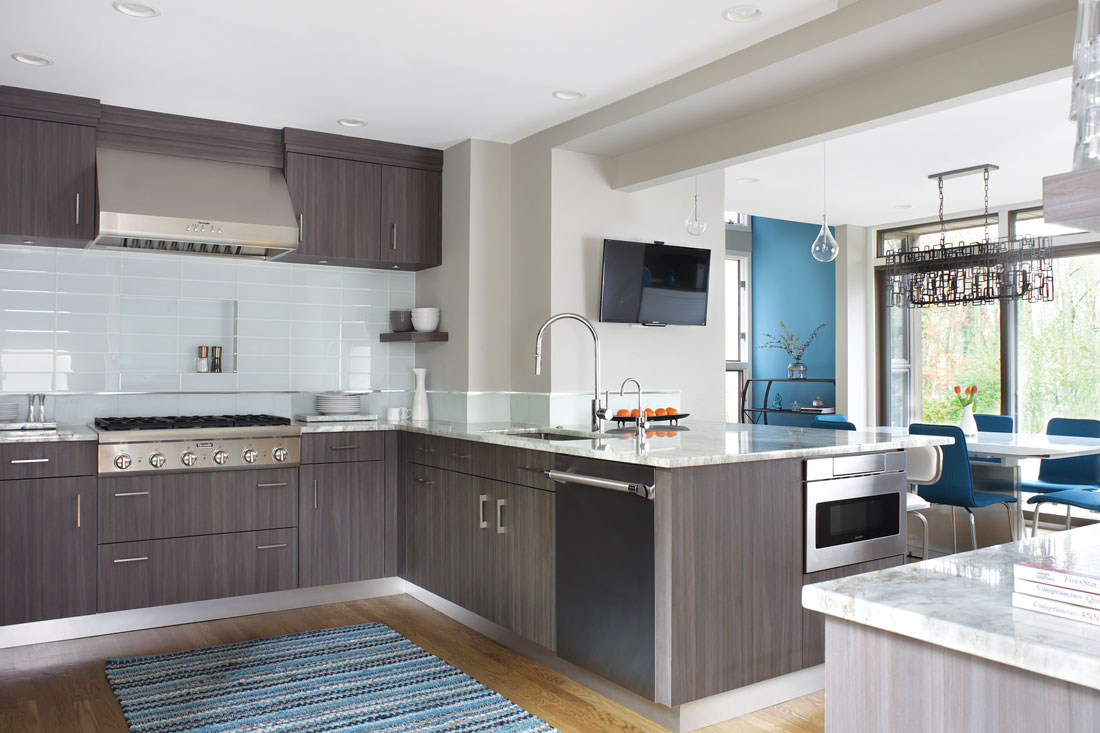Change of Venue
Writer Marirose Krall | Photographer Peter Rymwid | Designer Ulrich Inc. | Location Morris County, NJSwapping spaces is a practical solution in a Morris County, New Jersey, home.
What can be done about a space that’s just wrong? Jeri Freeman wrestled with that question when it was time to redo the kitchen in her home. The contemporary residence features an abundance of floor-to-ceiling windows, but none of those windows were located in the former kitchen. “It was dark,” Freeman says. “It was kind of odd that the kitchen — where I spend most of my time — was the darkest room in the house.”
Designer Julia Kleyman, a Certified Living in Place Professional and designer at Ridgewood, NJ-based Ulrich Inc., stepped in to help Freeman come up with a plan. “The homeowners were unhappy with the location of their kitchen,” Kleyman says. “The windows were hidden from everyday view. In addition, the family entertains a lot, so their wish list included a centrally located kitchen.”
The idea of adding a kitchen onto the house was quickly dismissed. “We didn’t want to go outside the envelope because we felt we had a decent space to work with,” Freeman says. Instead, Kleyman broached the idea of repurposing entire rooms. Kleyman and Freeman considered various rearrangement scenarios. “There were four or five places where we considered putting the kitchen,” Freeman says. “We tried pretty much every variation.”
Finally, Kleyman says, “we all agreed on one plan that worked best — moving the kitchen into what was a first-floor bedroom space to make it closer to the main staircase.” This strategic move would “link it with the breakfast and dining areas. The kitchen would have tall windows on both sides and be bathed in natural light.”
Even without building an addition, Kleyman points out, “it was an extensive renovation that entailed removing and building new walls, updating sliding doors, tying new wood flooring into the existing one and relocating multiple air conditioning ducts.”
Once the logistics were addressed, the designer and the homeowner chose a style in tune with the rest of the residence. Freeman calls the look “industrial contemporary.” For Kleyman, that translated into a streamlined, straightforward space. “The contemporary style of the house suggested the use of cabinetry with flat-panel doors in muted colors,” the designer says.
The finished space has a decidedly Midcentury Modern vibe. “It has clean, smooth lines,” Freeman says. Indeed, the cabinetry, backsplash and even the table and chairs consist of smooth planes, with texture coming in the form of simple, linear cabinet hardware and a sculptural light fixture above the table.
Against the unembellished background, Freeman chose chairs in a deep teal. “The color works,” she says, adding that the chairs suit her style perfectly. “I didn’t want anything too bulky or too cushioned. They’re comfortable. They fit the look.” The boldness of the blue chairs is balanced by a bright white table that stands out alongside the cabinets yet synchronizes with other elements in the space, such as the backsplash and the stools at the peninsula. “I didn’t really want a wood table,” Freeman says. She did, however, want a table that could open. “I can extend it when we have a lot of people over.”
The stainless-steel appliances are a major presence in the room. “They look sleek and hefty,” Kleyman notes, and they “complement the metal elements in the kitchen.” Those elements include the faucet, the trim on the chairs and stools and, interestingly, the trim around each backsplash tile. Kleyman describes the tile as “a simple design of gloss and matte glass with metal liners that emphasize the kitchen’s straight lines.” That was an ideal choice for Freeman. “I like wood and metal mixed, and nothing too perfect.”
For the countertop, the homeowner and the designer “found a beautiful quartzite called ‘Fantasy Brown,’” Kleyman says. It was chosen because it reflects the colors visible through the windows. “It has soft brown, green and gray waves and works well connecting the interior kitchen space with the outside.” Kleyman and Freeman worked well together themselves. Says Kleyman, “Jeri was very collaborative and open to different ideas and knew what she wanted.”



